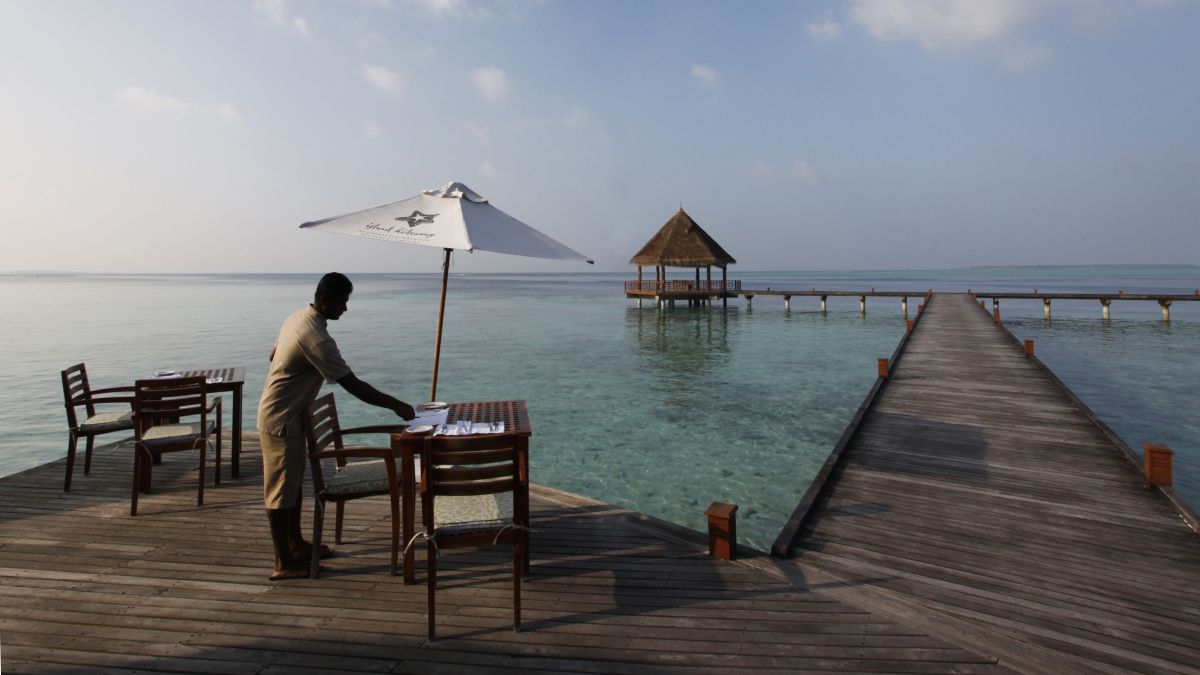Planning a visit to the Maldives?
Not only is visiting expensive, now you will have to shell out big bucks to leave as well.
The Indian Ocean archipelago nation has increased its exit fees.
But what happened? Just how much will it hit your wallet?
Let’s take a closer look:
What happened?
According to CNN, the Maldives has raised its exit fees as much as 400 per cent.
The change kicks in from December 1.
The departure tax is applicable to all non-Maldivians without regard to age or nationality.
According to OneMileAtATime.com, economy passengers will now have to pay $50 (Rs 4,221) compared to $30 (Rs 2,553).
Business class passengers will have to shell out $120 (Rs 10,132) as opposed to $60 (Rs 5,061).
Those travelling First class passengers will have to pay $240 (Rs 20,264) compared to $90 (Rs 7,599) earlier.
Those on private jets will have to shell out $480 (Rs 40,528) compared to $120 (Rs 10,132).
Interestingly, this exit fee does not take into consideration the length of your stay – from 1 hour to a week.
They will be added directly to the price of the ticket.
As per CNN, the Maldivian Inland Revenue Authority (MIRA) announced the revised charges in November.
The money generated from these fees goes toward maintenance and upkeep of Velana International Airport (MLE) – the Maldives’ main transit hub.
Impact Shorts
More ShortsExit fees aren’t the only thing going up.
The Maldives will be increasing its daily green tax on tourists from January.
The $6 (Rs 500) tax per tourist will be doubled to $12 Rs (1,000) for resorts that have more than 50 rooms.
For those resorts under 50 rooms, the tax will be increased from $3 (Rs 250) to $6 (Rs 500.)
Children under the age of two will be exempted from the green tax.
From July 2025, the Maldives will be increasing its goods and services tax from 16 to 17 to per cent.
The amendments to the tax laws were passed in Parliament in October, as per TravelMaldives.com.
The president ratified the changes on November 5.
Male’s foreign exchange crisis
The move comes in the backdrop of Male facing a foreign exchange crisis .
The country has limited types of transactions allowed in foreign currency and imposing mandatory foreign currency exchange controls on tourism establishments and banks.
The Maldivian economy appears to have taken a hit after calls to Indian tourists to avoid the picturesque island nation as a response to President Mohamed Muizzu’s ‘India Out’ campaign last year.
The International Monetary Fund (IMF) has also warned of a potential debt crisis.
Maldives Monetary Authority (MMA) on October 1 introduced a new regulation, requiring all foreign currency income generated by the tourism industry to be deposited in local banks.
MMA, which had in August imposed a strict dollar limit as Maldives found itself in a dollar shortage, published the new rules in the local Dhivehi language.
As per TTGAsia, Fitch in a recent report said the decline in foreign reserves to $492 million in May 2024 from $748 million a year earlier reflects a persistently high current account deficit.
Moody’s pegs the country’s total external debt obligations at between $600 million to $700 million in 2025.
It said this figure could rise to US$1 billion by 2026.
The finance minister in a letter dated August 31 said, “…we urgently need to move forward as proposed given the challenging fiscal and external position of the country.”
‘High taxes will kill industry’
The Ministry of Finance predicts the changes will swell the country’s coffers by Rs 8 billion.
The additional revenue from the airport development fee will be invested in the Sovereign Development Fund, as per the website.
However, not everyone is happy.
“…The high taxes will kill the industry,” one local owner told TTGAsia.
An international chain CEO, speaking on condition of anonymity, added, “We are urging the government (in a letter to the Ministry of Tourism) to delay these taxes and give the industry time to adjust to these changes as we have contracts running for more than six months. We are not opposed to the increased taxes but we are concerned about the timing of these changes.”
With inputs from agencies
)